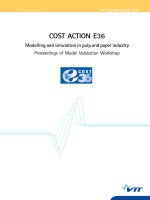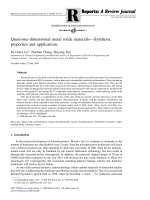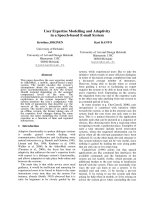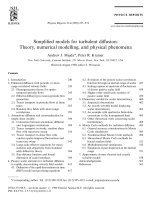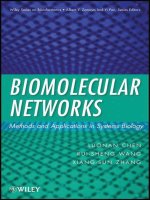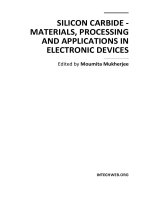Quasi brittle self healing materials numerical modelling and applications in civil engineering
Bạn đang xem bản rút gọn của tài liệu. Xem và tải ngay bản đầy đủ của tài liệu tại đây (11.34 MB, 228 trang )
QUASI-BRITTLE SELF-HEALING MATERIALS:
NUMERICAL MODELLING AND APPLICATIONS IN
CIVIL ENGINEERING
TRAN DIEP PHUOC THAO
NATIONAL UNIVERSITY OF SINGAPORE
2011
QUASI-BRITTLE SELF-HEALING MATERIALS:
NUMERICAL MODELLING AND APPLICATIONS IN
CIVIL ENGINEERING
TRAN DIEP PHUOC THAO
(B.Eng. Civil (Hons))
A THESIS SUBMITTED
FOR THE DEGREE OF DOCTOR OF PHILOSOPHY
DEPARTMENT OF CIVIL AND ENVIRONMENTAL ENGINEERING
NATIONAL UNIVERSITY OF SINGAPORE
2011
i
Acknowledgements
I would like to express my deepest thanks to my parents and my dear wife, Phuong
Thuy, who are always beside me to support me throughout these years. Their loves
are valuable encouragements that provide me with enough motivation to overcome all
obstacles in my study.
I would also like to express my sincerest appreciation to my supervisors, Dr. Pang Sze
Dai and Prof. Quek Ser Tong for their guidance and advice so that I can complete this
study. They are wonderful supervisors who have taught me many things, not only in
research but also in my normal life. I am very grateful for their support and care.
Working with them is an unforgettable memory in my life.
I would like to acknowledge the National University of Singapore (NUS) for their
support with Research Scholarship.
I would like to thank my fellow students, especially Mr. Lim Fung Hong, Mr. Zhang
Yushu and Ms. Ng Ai Ching. A special thank to my best friend in NUS, Mr. Elliot
Law, for all of his help and interesting discussions during our daily lunch.
ii
Table of Contents
Acknowledgement i
Table of Contents ii
Summary vii
List of Tables ix
List of Figures x
List of Symbols xi
Chapter 1: Introduction 1
1.1 General remarks 1
1.2 Literature reviews 3
1.2.1 Natural self-healing systems 3
1.2.2 Artificial self-healing systems 5
1.2.2.1 Strategy to create artificial self-healing system 5
1.2.2.2 Bio-inspired self-healing materials with tubular
system 8
1.2.2.3 Bio-inspired self-healing materials with
microcapsulated system 13
1.2.3 Summary 18
1.3 Objectives and Scopes 22
1.4 Organization of Thesis 25
Chapter 2: Approaches to model mechanical behaviors of
composites 27
2.1 Introduction 27
2.2 Hierarchical approach 27
iii
2.2.1 Overall strategy 27
2.2.2 Computational models 28
2.2.2.1 Global – local analysis models 28
2.2.2.2 Superposition based models 30
2.2.2.3 Macro – micro hierarchical model 31
2.2.2.4 Domain decomposition model 32
2.2.2.5 Multi-level finite element models 33
2.2.2.6 Concurrent multi-level model 34
2.2.3 Advantages and disadvantages of hierarchical approach 36
2.3 Homogenization approach 37
2.3.1 Overall strategy 37
2.3.2 Theoretical models 38
2.3.2.1 Voigt’s and Reuss’ models 38
2.3.2.2 Dilute distribution model 39
2.3.2.3 Hashin – Strikman bounds 41
2.3.2.4 Self-consistent and Generalised Self-consistent models 42
2.3.2.5 Mori – Tanaka model 44
2.3.3 Numerical approach using RVE concept 45
2.3.3.1 Single-particle RVE approach 49
2.3.3.2 Multiple-particle RVE approach 50
2.3.3.3 Image based RVE approach 52
2.3.4 Remarks on homogenization approach 54
2.3.4.1 Comparison between analytical models and RVE
approach 54
2.3.4.2 Advantages and limitations of homogenization
approach 56
2.4 Summary 56
iv
Chapter 3: RVE approach for modelling the mechanical properties
of quasi-brittle composites 59
3.1 Introduction 59
3.2 Experimental data and numerical set up 62
3.2.1 Experimental data 62
3.2.2 Numerical set up 63
3.2.2.1 RVE generation 63
3.2.2.2 Periodicities of a RVE 65
3.2.2.3 Material constitutive law 68
3.2.2.4 Loading condition and other numerical issues 69
3.3 Homogenized stress-strain curve of RVE 70
3.3.1 Prediction of elastic response 70
3.3.1.1 Results from numerical simulations using RVE
approach 70
3.3.1.2 Comparison of the predictions from RVE approach
and theoretical models 77
3.3.2 Prediction of inelastic response 79
3.4 Fracture energy predicted using RVE approach 85
3.5 Summary 90
Chapter 4: Numerical simulation of self-healing materials with
capsulated system 93
4.1 Introduction 93
4.2 Preliminary studies on elastic response of micro-capsules 95
4.2.1 Experimental results from micro-compression test 95
4.2.2 Finite element model using bi-phasic materials 97
4.2.2.1 Boundary conditions and loading 97
v
4.2.2.2 Material model and element type 98
4.2.2.3 Results and discussion 100
4.3 Numerical simulations to capture material properties of micro-
capsule based SHM 102
4.3.1 Published experimental data and remarks 102
4.3.2 Numerical model 104
4.3.2.1 RVE generation 104
4.3.2.2 Material models 105
4.3.2.3 Loading condition and other numerical issues 107
4.3.3 Prediction of Young’s modulus and strength 107
4.3.4 Prediction of healing efficiency 111
4.3.4.1 Calibrating ε
max
for virgin fracture toughness 112
4.3.4.2 Capturing healing effect 115
4.4 Numerical simulation of structural behaviour of self-healing
beams 119
4.4.1 Numerical set up 119
4.4.2 Simulation with reference beam 121
4.4.3 Simulation with self-healing beam using capsulated system 124
4.4.4 Comparison with self-healing beam using tubular system 127
4.5 Summary 132
Chapter 5: Applications of self-healing concept in civil engineering 135
5.1 Introduction 135
5.1.1 Autogenous self-healing concrete 136
5.1.2 Autonomic self-healing concrete 138
5.1.3 Remarks 140
5.2 Preliminary studies 143
vi
5.2.1 Selection of healing agent and storage system 143
5.2.2 Proof-of-concept experiments 149
5.2.2.1 Materials and specimens preparation 149
5.2.2.2 Test procedure 150
5.2.2.3 Results and discussions 151
5.2.3 Implementation issues of self-healing system in structural
members 153
5.2.3.1 Protection of self-healing system 153
5.2.3.2 Detection of breakage of glass tube 158
5.3 Implementation of self-healing function in reinforced concrete
beam 159
5.3.1 Specimens fabrication and testing procedure 159
5.3.1.1 Beams under three-point bending experiments 159
5.3.1.2 Beams under four-point bending experiments 161
5.3.2 Results and discussions 162
5.3.2.1 Beams under three-point bending experiments 162
5.3.2.2 Beams under four-point bending experiments 164
5.4 Implementation of self-healing function in reinforced concrete
column 165
5.4.1 Specimens fabrication and testing procedure 166
5.4.2 Results and discussions 167
5.5 Implementation of self-healing function in reinforced concrete
slab 170
5.5.1 Specimens fabrication and testing procedure 170
5.5.2 Results and discussions 172
5.6 Summary 173
Chapter 6: Conclusions and recommendations for future work 175
vii
6.1 Conclusions 175
6.2 Recommendations for future works 179
6.2.1 Extension of RVE approach to predict shear-related
material properties 179
6.2.2 Optimized design for micro-capsule based SHM 180
6.2.3 Design for self-healing structure 180
6.2.4 Effect of crack healing regime 181
6.2.5 Novel self-healing system for reinforced concrete 183
References 185
Appendix 1 Material Safety Data Sheet – POR15 201
Appendix 2 Material Safety Data Sheet – AQUA STICK 203
List of publications 207
viii
Summary
Self-healing materials (SHM) is a novel class of smart material which can
detect and repair damages automatically. From the beginning, researches in this field
have been targeted towards aerospace applications. Multiple experiments have been
conducted to enhance the self-healing performance. To complement the experimental
effort, a numerical model that is able to predict the macro behaviour of this composite
is necessary. To tap on the potential of this smart material, attempts have been made
to extend the self-healing concepts to cementitious materials for civil engineering
applications, where the automatic crack repair can help to increase the durability of
the material or to reduce the loss of stiffness and strength of the structure. The
objectives of the current study are to develop a numerical modelling strategy that can
efficiently predict the macro behaviour of SHM and to extend the self-healing concept
to reinforced concrete, the most commonly used civil engineering material.
Firstly, Representative Volume Element (RVE) approach was examined in
detail based on simulations with porous epoxy. The simulations show that Multiple-
Particle RVE (MP-RVE) approach is suitable for predicting the properties, both
elastic and inelastic, of composites containing high volume fraction of
reinforcements; and fracture energy, which is a size invariant property, should be used
to simulate the damage behaviour of heterogeneous materials.
The RVE approach has been adopted to develop a numerical model to predict
material properties of micro-capsule based SHM. Findings from a preliminary study
suggest that the micro-capsules, which are much softer than the matrix, can be
modelled as voids in the RVEs. The shear-yielding effect of the micro-capsules on the
ix
post-elastic behaviour of the composite is modelled by introducing shear retention in
the smeared crack model. Good predictions of Young’s modulus, strength, and
healing efficiency have been achieved.
A numerical simulation of simply supported beam under three-point bend was
carried out to study the effect of self-healing on structural behaviour. The result shows
that healing with low strength healing agent is inefficient as the healed cracks will
reopen. Ideally, self-healing beam using capsulated system may recover load bearing
capacity and stiffness better but this system need more amount of healing agent. On
the other hand, self-healing beam using tubular system sacrifices some degree of
healing to concentrate on healing only severe cracks.
Lastly, self-healing function was implemented in reinforced concrete as an
extension of self-healing concept to civil engineering applications. It was found that
the one-part air curing adhesive Isocyanate Prepolymer (POR-15) encapsulated in a
hollow glass tubes is a promising self-healing unit. Protected by using spiral wires
coated with a thin mortar layer, the proposed self-healing units were implemented in
three key reinforced concrete structural members, at structural scale, namely beam,
column and slab to test the healing efficiency, in terms of stiffness recovery. The self-
healing beam exhibited multiple crack healing capabilities with 84% of the flexural
stiffness being recovered. Self-healing function was also introduced in column
element where healing efficiency of up to 70% was reported. Multiple crack healings
were observed in the self-healing slab with the maximum healing efficiency of 99%.
x
List of Tables
Table 2.1 Global – local analysis approach for a laminated composite
panel
29
Table 3.1 Mechanical properties of porous epoxy 63
Table 3.2 Prediction of elastic properties of porous epoxy using RVE
approach
71
Table 3.3 Measured and predicted Young’s modulus of porous epoxy 77
Table 3.4 Prediction of strength of porous epoxy using RVE
approach
80
Table 3.5 Prediction of fracture energy and fracture toughness of
porous epoxy using RVE approach
86
Table 4.1 Mechanical properties of micro-capsule based SHM 103
Table 4.2 Effective Young’s modulus of micro-capsule based SHM 108
Table 4.3 Effective strength of micro-capsule based SHM 111
Table 4.4 Effective fracture toughness of micro-capsule based SHM 114
Table 4.5 Healed fracture toughness of micro-capsule based SHM 117
Table 4.6 Results from simulations with CS-LS and CS-HS beams 127
Table 4.7 Results from simulations with CS-HS and TS-HS beams 129
Table 5.1 Summary of proof-of-concept experimental results 153
Table 5.2 Properties of materials used for reinforced concrete beam 160
Table 5.3 Stiffness of control and self-healing slabs under impact
loading
173
xi
List of Figures
Figure 1.1 Replacement-based healing mechanism of human bone 4
Figure 1.2 Bleeding-based healing mechanism 4
Figure 1.3 Strategy to create artificial self-healing material 6
Figure 1.4 Selective healing system 10
Figure 1.5 Schematic of different hollow fiber SHM approaches 11
Figure 1.6 SHM using hollow glass fibers 12
Figure 1.7 Micro-capsule based SHM 13
Figure 1.8 Optical micrograph at crack tip of self-healing polymer
composite under fatigue loading
16
Figure 2.1 Schematic diagram of hierarchical approach 28
Figure 2.2 Hierarchical modelling of woven composites 31
Figure 2.3 Hierarchical modelling of WC/Co hard metal 32
Figure 2.4 Schematic of coupled-volume approach 34
Figure 2.5 Schematic of concurrent multi-level model 35
Figure 2.6 Schematic diagram of homogenization approach 37
Figure 2.7 Schematic diagram of CSA model 41
Figure 2.8 Schematic of theoretical models to homogenize composites 43
Figure 2.9 Schemes to define RVE 48
Figure 2.10 SP-RVE models 49
Figure 2.11 Interface decohesion modelling with MP-RVE approach 52
Figure 2.12 3D image based RVE 54
Figure 3.1 Typical RVEs at volume fraction f=5% 65
Figure 3.2 Periodicities of RVE 66
Figure 3.3 Constitutive law for epoxy expressed in terms of stress
versus displacement and crack opening displacement
68
xii
Figure 3.4 Effective Young’s modulus obtained from RVE
approaches and experiments
72
Figure 3.5 (a) Description of a Voronoi cell; (b) Non-overlapping
boundaries for critical size of SP-RVE in composite with
low volume fraction of inclusions; (c) Overlapping
boundaries for critical size of SP-RVE in composite with
high volume fraction of inclusions.
73
Figure 3.6 Finding critical volume fraction for SP-RVE approach
using Drugan and Willis criterion
76
Figure 3.7 Measured and predicted Young’s modulus of porous epoxy
using theoretical models and RVE approaches
78
Figure 3.8 Stress-strain curves obtained by RVEs at f=5% 80
Figure 3.9 Predicted stress-strain behavior of composites containing
30% of inclusion using RVE of different sizes
82
Figure 3.10 (a) Idealized fiber bundle model for describing load
distribution in a RVE for a bi-phasic composite; (b) stress-
strain curves for brittle phases 1 and 2; (c) stress-strain
curves brittle phase 1 and elasto-plastic phase 2.
83
Figure 3.11 Effective fracture toughness obtained from RVE
approaches and experiments
88
Figure 3.12 Simulation of cracks in porous epoxy using smeared crack
model
89
Figure 4.1 Dry and immersed compression test on the micro-capsule 96
Figure 4.2 Finite element model of compressive test for micro
capsules
98
Figure 4.3 Results from FE simulation of micro-capsule under
compression
101
Figure 4.4 Effective Young’s modulus obtained from RVE
approaches and experiments
109
Figure 4.5 Effective strength obtained from RVE approaches and
experiments
110
Figure 4.6 Steps to capture healing efficiency of micro-capsule based
SHM
116
Figure 4.7 Tapered double cantilever beam K
IC
characterization of
micro-capsule based SHM
116
xiii
Figure 4.8 Healing efficiency of micro-capsule based SHM:
numerical prediction versus experimental data
119
Figure 4.9 Numerical set up of self-healing beam 120
Figure 4.10 Results from simulation of reference beam 122
Figure 4.11 Structural behaviour of reference beam 123
Figure 4.12 Before and after healing states at critical zone of self-
healing beam using capsulated system
126
Figure 4.13 Cracks appearance in TS-HS beam for the first healing 129
Figure 4.14 Results of simulations of self-healing beams after the
second healing
131
Figure 5.1 Bacteria-based self-healing concrete 138
Figure 5.2 Shape memory polymer-cementitious composite 140
Figure 5.3 Encapsulation of Isocyanate Prepolymer 145
Figure 5.4 Leakage of adhesive when araldite was used as sealant 147
Figure 5.5 Testing for the leakage of POR-15 using tubes in Groups A
and B
148
Figure 5.6 Self-healing system for autonomic bleeding test 150
Figure 5.7 Experimental results of self-healed specimen 152
Figure 5.8 Testing for protected self-healing units 154
Figure 5.9 Self-healing unit protected with 6.5 strip mortar and the
surrounding concrete
155
Figure 5.10 Protections for self-healing unit 157
Figure 5.11 Detection of glass tube rupture using optical fiber 158
Figure 5.12 Self-healing beam under three-point bending test 160
Figure 5.13 Self-healing reinforced concrete beam under four-point
bending test
161
Figure 5.14 Load displacement curve of beams under three-point
bending test
162
Figure 5.15 Normalized stiffness of control beam and self-healing
beam
163
xiv
Figure 5.16 Result of self-healing beam under four-point bending test 165
Figure 5.17 Elevation and cross sectional views of self-healing column 167
Figure 5.18 Results for cantilevered columns test 168
Figure 5.19 Experiments on self-healing slab 171
Figure 5.20 Stiffness of control and self-healing slabs under impact
loading
173
Figure 6.1 Three crack healing regimes and application in an RC
beam
181
Figure 6.2 Hybrid tubular-micro-capsulated self-healing system 183
xv
List of Symbols
a Edge length of RVE
D Diameter of inclusion
E Young’s modulus
f Volume fraction of inclusion
G Shear modulus
G
cr
Cracked shear modulus
G
f
Fracture energy
I
1
Deviatoric strain invariant
K Bulk modulus
K
IC
Fracture toughness of material
n Number of inclusions
S Eshelby tensor
U Strain energy potention
u Displacement
V Volume
w
max
Maximum crack opening displacement
x Coordinate
ε Strain
ε
c
Constrained strain
ε
t
Eigenstrain
xvi
ε
cr
Direct strain across the crack
ε
max
Direct strain across the crack corresponding to the zero shear
retention state
λ Principle stretch
η Healing efficiency
ν Poisson’s ratio
ρ Shear retention factor
σ Stress
σ
f
Strength of material
xvii
List of Acronyms
BC Boundary Condition
CSA Composite Sphere Assemblage
DCB Double Cantilever Beam
DD Dilute Distribution
FEM Finite Element Method
GSC Generalizes Self Consistent
HGF Hollow Glass Fiber
MP-RVE Multiple-Particle RVE
PBCs Periodic Boundary Conditions
RSA Random Sequential Adsorption
RVE Representative Volume Element
SC Self Consistent
SEM Scanning Electron Microscope
SHB Self-Healing Beam
SHC Self-Healing Column
SHM Self-Healing Materials
SHU Self-Healing Unit
SP-RVE Single-Particle RVE
xviii
THIS PAGE IS INTENTIONALLY LEFT BLANK
Chapter 1
INTRODUCTION
1
CHAPTER 1
INTRODUCTION
1.1. GENERAL REMARKS
Along the development of material science, the objective of material research, in
terms of mechanical behavior, keeps changing from the starting point of finding stronger
materials finding high performance materials. Over a few recent decades, advanced
materials such as smart materials, multi-functional materials and sustainable materials
have attracted the attention of material scientists. No matter how the focus in material
research changes, cracking is always the essential issue need to be resolved. The
existence of crack in material, regardless of how well it is designed or manufactured, is
almost unavoidable as micro-cracks can be initiated during the processing of the material
due to non-uniform heating and cooling which give rise to residual stresses, or rough
handling of the material. Owing to the creep or fatigue effects during service condition
caused by electrical, mechanical and/or thermal loading, these micro-cracks can grow and
induced more severe macro-cracking phenomenon such as crack bridging at grain
boundaries, debonding at matrix–reinforcement interface or delamination in sandwich or
laminated panels, resulting in degradation of material properties.
In materials which are brittle or quasi-brittle, such as polymer composites and
concrete, the long-term degradation is highly undesirable. Especially, when the structure
Chapter 1
INTRODUCTION
2
is under-designed or accidental loadings are imposed, the presence of cracks at critical
locations increases the vulnerability of the structure. In such cases, if the damage
structure is left unrepaired, a sudden catastrophic structural failure may happen and cause
some severe losses in property or even human death. Thus, overhaul or regular
maintenance, which is costly in many cases particularly in civil and aerospace
applications, is necessary to ensure safety and prolong the lifespan of the structure. For
example, the average annual maintenance cost for bridges in US is estimated at $5.2
billion (Yunovich and Thompson, 2003). Even with a costly regular maintenance and
overhaul, the probability that a catastrophic failure happen can only be reduced to a
certain level, rather than being zero as in ideal cases. The collapse of a highway overpass
in Quebec in 2006, which happened after the annual inspection, is an obvious example.
The fact that the probability of a sudden catastrophic failure cannot be reduced to zero is
because in many instances, including of the above failure of the highway overpass in
Quebec, damages are too fine or embedded too deep inside the structure so that they
cannot be detected by conventional methods and equipments. Therefore, finding a
reliable detection and repair method to solve cracking problem is a very challenging and
practical issue nowadays.
As a promising solution for the aforementioned cracking problem, self-healing
materials has become an attractive topic to researchers over the past few years. The main
idea of this novel material is to embed a self-sensing and repairing mechanism within the
materials to prevent further damage and recover its material properties such as stiffness,
strength and fracture toughness automatically. Indeed, this self-healing system is not
entirely new and can be found in almost all living organisms. Through years of evolution,
Chapter 1
INTRODUCTION
3
the sensing and healing network in biological materials are optimized to adapt to their
living environment. Obvious examples are the growth of tissue in cuts and abrasions of
animal skin, or the remodeling of bone when there are fractured. Mimicking nature, many
efforts have been made, experimentally, to find efficient ways to produce self-healing
materials and some first promising results have been published recently.
In the next section of this chapter, the self-healing mechanisms in nature will be
reviewed in detail. Then, a general strategy to create artificial self-healing mechanism in
material will be presented together with a review on achievements in literature.
1.2. LITERATURE REVIEWS
1.2.1. Natural self-healing systems
In nature, living organisms heal themselves by either replacement or bleeding
mechanism. The former mechanism is exhibited in the repair of bones with micro stress
fractures or the repair of trees from cutting. Figure 1.1 describes the replacement
mechanism in human bone. There are 2 different types of cells, the osteoclasts and the
osteoblasts, within each repair unit called basic multicellular unit (BMU). While the
osteoclasts remove the old and damaged part of the bone, the osteoblasts generate new
ones to maintain the bone’s integrity. In order to mimic this mechanism artificially, one
has to create two separate automatic systems for destruction and generation, which is still
at present formidable to mimic. Moreover, effective bonding between new and old
material is another difficult issue to content with satisfactorily.
Chapter 1
INTRODUCTION
4
Figure 1.1: Replacement-based healing mechanism of human bone.
(after David Taylor et al., 2007)
Fortunately, there is a simpler way of self-repair in nature which is based on
bleeding mechanism. Figure 1.2 shows an example of bleeding-based autonomic healing
process. When a cut through an animal skin is made, the intercepted blood vessels rupture
and blood is released into the cut or wound. The blood functions as a self healing agent
that contains clotting chemicals which can coagulate and mend the wound. The two key
factors of this mechanism are (a) presence of a healing agent (blood) which is stored in
containers (vessels), and (b) the damage has to rupture the containers to trigger the
healing process. Compared to replacement mechanism, this approach is more practical
and easier to mimic.
Figure 1.2: Bleeding-based healing mechanism.
(after Martha J. Heil, 2005 and William Matsui, 2007)
Chapter 1
INTRODUCTION
5
1.2.2. Artificial self-healing systems
1.2.2.1. Strategy to create artificial self-healing system
An artificial strategy to create autonomic repairing ability in material has been
developed in recent years, which mimics closely the bleeding-based healing mechanism.
The strategy is described by the flow diagram in Figure 1.3. Mimicking the bleeding-
based healing mechanism in nature, the artificial self healing units comprise of the
container and healing agent. These units are embedded inside the neat material to create
the self healing function. The container serves both to contain the healing agent and act as
a barrier to prevent any reactions between the healing agent and the neat material. When
the propagating crack ruptures the container, the healing agent is released into the crack
by capillary action or gravity. Chemical reaction takes place between the healing agent
and neat material or between parts of healing agent (in the case of 2-parts epoxy) to
create bonding between the crack planes and alter the crack tip’s shape. Because of this
healing process, it can stop the crack propagation and material properties such as
stiffness, fracture toughness and strength may be recovered.
